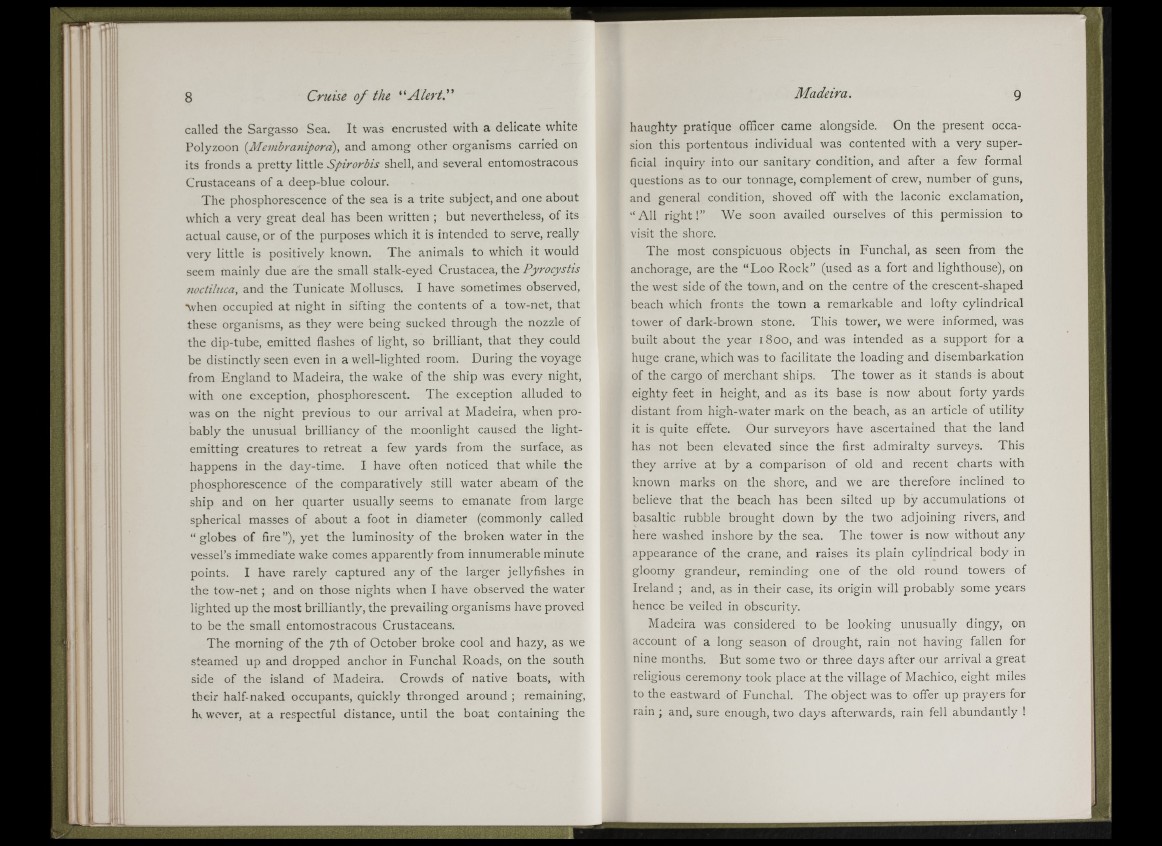
8 Cruise o f the Alert.”
called the Sargasso Sea. It was encrusted with a delicate white
Polyzoon (AIembranipord), and among other organisms carried on
its fronds a pretty little Spirorbis shell, and several entomostracous
Crustaceans of a deep-blue colour.
The phosphorescence of the sea is a trite subject, and one about
which a very great deal has been written ; but nevertheless, of its
actual cause, or of the purposes which it is intended to serve, really
very little is positively known. The animals to which it would
seem mainly due are the small stalk-eyed Crustacea, the Pyrocystis
iioctiluca, and the Tunicate Molluscs. I have sometimes observed,
when occupied at night in sifting the contents of a tow-net, that
these organisms, as they were being sucked through the nozzle of
the dip-tube, emitted flashes of light, so brilliant, that they could
be distinctly seen even in a well-lighted room. During the voyage
from England to Madeira, the wake of the ship was every night,
with one exception, phosphorescent. The exception alluded to
was on the night previous to our arrival at Madeira, when probably
the unusual brilliancy of the moonlight caused the light-
emitting creatures to retreat a few yards from the surface, as
happens in the day-time. I have often noticed that while the
phosphorescence of the comparatively still water abeam of the
ship and on her quarter usually seems to emanate from large
spherical masses of about a foot in diameter (commonly called
“ globes of fire”), yet the luminosity of the broken water in the
vessel’s immediate wake comes apparently from innumerable minute
points. I have rarely captured any of the larger jellyfishes in
the tow-net ; and on those nights when I have observed the water
lighted up the most brilliantly, the prevailing organisms have proved
to be the small entomostracous Crustaceans.
The morning of the 7th of October broke cool and hazy, as we
steamed up and dropped anchor in Funchal Roads, on the south
side of the island of Madeira. Crowds of native boats, with
their half-naked occupants, quickly thronged around ; remaining,
h..wevcr, at a respectful distance, until the boat containing the
Madeira.
haughty pratique officer came alongside. On the present occasion
this portentous individual was contented with a very superficial
inquiry into our sanitary condition, and after a few formal
questions as to our tonnage, complement of crew, number of guns,
and general condition, shoved off with the laconic exclamation,
“ All right!” We soon availed ourselves of this permission to
visit the shore.
The most conspicuous objects in Funchal, as seen from the
anchorage, are the “ Loo Rock” (used as a fort and lighthouse), on
the west side of the town, and on the centre of the crescent-shaped
beach which fronts the town a remarkable and lofty cylindrical
tower of dark-brown stone. This tower, we were informed, was
built about the year 1800, and was intended as a support for a
huge crane, which was to facilitate the loading and disembarkation
of the cargo of merchant ships. The tower as it stands is about
eighty feet in height, and as its base is now about forty yards
distant from high-water mark on the beach, as an article of utility
it is quite effete. Our surveyors have ascertained that the land
has not been elevated since the first admiralty surveys. This
they arrive at by a comparison of old and recent charts with
known marks on the shore, and we are therefore inclined to
believe that the beach has been silted up by accumulations oi
basaltic rubble brought down by the two adjoining rivers, and
here washed inshore by the sea. The tower is now without any
appearance of the crane, and raises its plain cylindrical body in
gloomy grandeur, reminding one of the old round towers of
Ireland ; and, as in their case, its origin will probably some years
hence be veiled in obscurity.
Madeira was considered to be looking unusually dingy, on
account of a long season of drought, rain not having fallen for
nine months. But some two or three days after our arrival a great
religious ceremony took place at the village of Machico, eight miles
to the eastward of Funchal. The object was to offer up prayers for
rain ; and, sure enough, two days afterwards, rain fell abundantly !